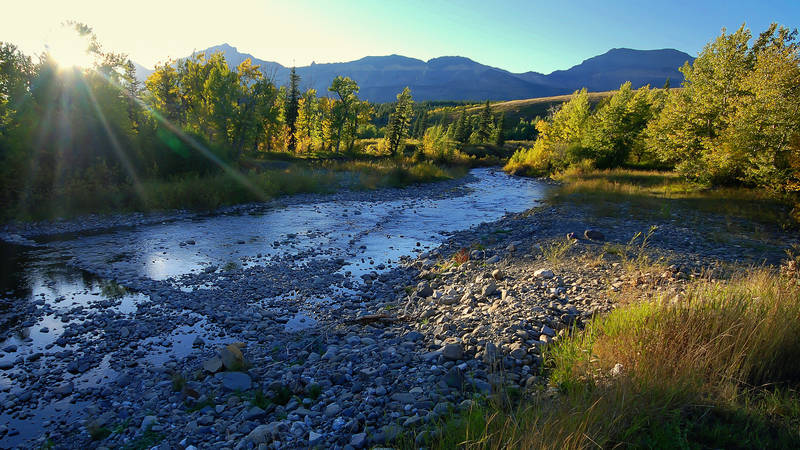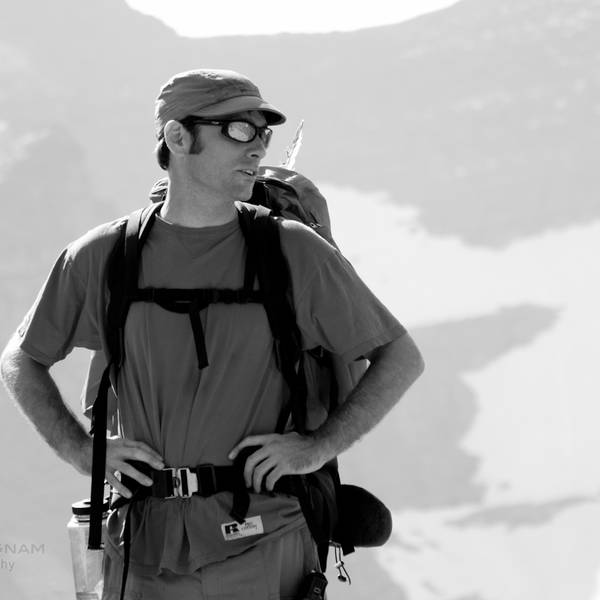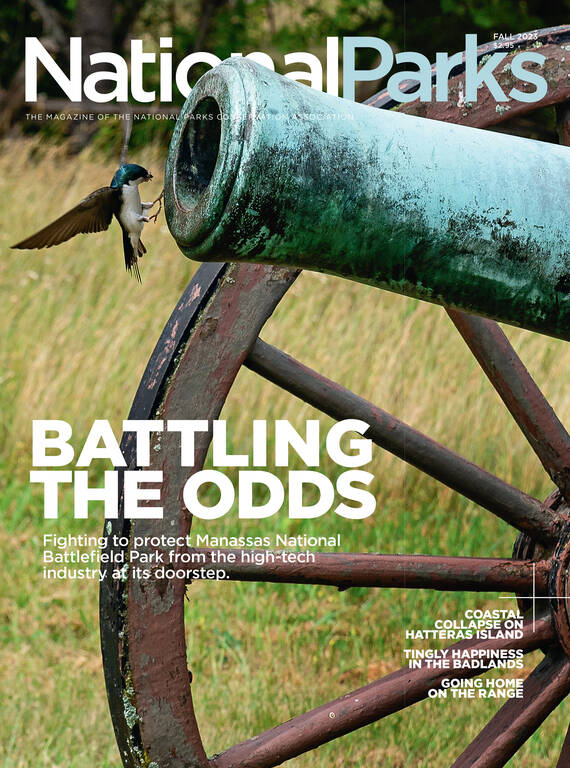Fall 2023
‘How We Heal’
The Blackfeet Nation’s effort to restore bison reached a milestone this summer with the release of a free-roaming herd onto sacred lands adjacent to Glacier National Park.
In the end, it was as simple as swinging open a gate.
First out was a rust-red calf, legs unsure against the solid ground of a Rocky Mountains meadow. Then in an instant a whole herd of shaggy bison surged, hooves flashing, tails up, eyes wide, a long-awaited storm of buffalo power thundering into the wild.
These “iinniiwa,” as they are known to the Blackfeet Tribe, are the first free-roaming bison ever to be unleashed onto the North American prairie by a sovereign Tribal government. In the blue-sky warmth of a fine June day, the herd of nearly 50 flowed like a river across prairie grassland. A wake of dust trailed them over a wildflower rise, and they disappeared single file into timber a mile to our west. Last we saw them, they were heading toward Glacier National Park.
And the land knew exactly how to welcome them back.
“We no longer have to ask permission to be Blackfeet,” Tribal councilman Lauren Monroe Jr. declared as the dust settled. “We will live it, and we will live it without fear.”
Blackfeet always have been buffalo people. For Tribal members, iinniiwa were, are and will remain a sacred source of food, spiritual nourishment, tools, shelter and clothing. Buffalo are life. (While bison species and buffalo species are distinct, Native American communities often refer to American bison as buffalo.)
The U.S. government understood fully the importance of bison to Plains Indian Tribes, including to the Siksikaitsitapi people of the Blackfoot Confederacy, which is why, throughout our nation’s Indian Wars, the unofficial policy was to slaughter the animals as a path to subjugating the continent’s First Nations. During the 1800s, North America’s bison population was devastated, butchered from vast herds of at least 30 million animals to fewer than 1,000 buffalo by 1889. At the same time, the Tribe’s cultural ceremonies celebrating iinniiwa were banned by the U.S. Code of Indian Offenses. Those prohibitions weren’t lifted until 1978, long after the herds were ravaged and far too late to avoid a profound ecological and cultural collapse.
Old prejudices persist, and wild buffalo remain a source of deep controversy. Bison are treated, generally, as livestock rather than wildlife and contained behind fences. Even down in Yellowstone country, where they roam freely within the national park, buffalo are killed or captured when they wander too far beyond park boundaries. In the 113 years since Glacier was made a park, there has never been a single buffalo within its boundary. Until now.

The Voice of Glacier
Ranger Doug Follett reflects on 50 Years at Glacier National Park.
See more ›It is no accident Blackfeet chose to release this wild herd along a spectacular Montana mountain front they call “Mō’okǎkkin,” the Backbone of the World. Standing at the head of this craggy spine is Chief Mountain, “Ninnāasṫǔkoō,” where the Blackfeet spirit of Thunder lives on a sacred summit that stands square and broad as a buffalo’s shoulders. Chief Mountain’s summit also is home to the borderline between the Blackfeet Indian Reservation and Glacier, a contested boundary that cleaves the peak just as surely as it does Blackfeet lifeways. The border runs through lands that were taken from the Blackfeet Nation in 1895, and that the Tribe continues to claim as Blackfeet territory.
In the context of this history, these wild buffalo seem not unlike a kind of Trojan horse — packed inside them are Blackfeet expressions of sovereignty, treaty rights and land claims. They also represent language, tradition and cultural practice. Conservation. Biology. Beavers, elk and cutthroat trout. Song and sacred ceremony. Entire watersheds. The age-old buffalo economy.
They carry the heavy burden of our collective expectations.
The seeds for the release were planted 150 years ago when, as the buffalo slaughter raged around him, Atatíc’ e captured a small remnant herd of iinniiwa on what is today the Blackfeet Indian Reservation. It was an act of optimism, perhaps, of defiance certainly, and likely of desperation. Later, in 1907, his growing captive herd was transferred to Elk Island National Park in Alberta, Canada, where it now numbers about 400.
The relentless pursuit of cultural survival begun by Atatíc’ e was amplified by Blackfeet leaders in 2016. That year, the Blackfeet Nation brought home 87 bison calves from Elk Island, direct descendants of the wild buffalo captured back in 1873. Over a half-dozen years, those 87 calves have grown into a strong Tribal herd — the genetic reservoir now spilling over to rewild the Blackfeet-Glacier front. “They are our ancestors,” said Helen Augare, who leads the Native Science Field Center at Blackfeet Community College. “And they are our future.”
Many people spent many years carefully planning the bison release. Wildlife biologists and Blackfeet elders. National Park Service managers and Tribal traditionalists. There were constant meetings, countless and complex details. NPCA is among the many partners who worked alongside the Tribe for more than a decade. I personally have been involved, in one way or another, for most of the past 40 years, since I was a sophomore in college.
Despite the long history, as the reintroduction approached, concerned ranchers and local land managers still were asking their Blackfeet neighbors questions about what might happen once the buffalo were released. Tyson Running Wolf told them not to worry. The herd would wander the prairie lands, the Blackfeet leader said. They would eat grass and cool themselves in pothole wallows. Grizzly bears would chase them. So would wolves. Blackfeet would hunt them. In other words, Running Wolf assured them, it would be much as it has been for the past 13,000 years.
For traditional cultures, these are simply the rhythms of the land. You can’t grow a healthy prairie grassland, after all, without wolves, wildfire and iinniiwa. Wolves push the buffalo so they don’t overgraze; buffalo trim and fertilize the grassland so energy flows to deep-seated roots; fire scours dry chaff so nutrients can cycle back into the soil. Together, these are the bioengineers sculpting the physical and cultural landscapes. And this Ninnāasṫǔkoō area, Running Wolf said, is one of the few remaining places on the planet where full restoration may be possible. Chief Mountain is a modern miracle, he said, where the cultural fabric remains intact, where Indigenous lifeways persist, where the natural systems remain unbroken and where there are few, if any, industrial pressures. Chief Mountain is, to borrow a well-worn Montana phrase, the last best place, and these iinniiwa are our last best hope.
Though decades in the making, the final decision to release wild buffalo came so quickly as to feel like a surprise. In the end, there weren’t any bureaucratic hoops or federal approvals. It was simply a Blackfeet decision, made by Blackfeet leaders on Blackfeet land and on behalf of Blackfeet cultural survival.
This is how we rebuild. This is how we restore. This is how we heal.
And so it felt surreal, dreamlike even, when all that effort and controversy was distilled into the mundane creak of a gate. Opening the fences felt vaguely dissident, marking, in some ways, a subversive rewilding, a defiant affirmation of Indigenous rights and Tribal sovereignty.
“It’s fitting that the first one that jumped out was a calf,” Augare said. “This is how we rebuild. This is how we restore. This is how we heal.”
In a statement released afterward, Blackfeet leaders wrote, “Today we are expressing our sovereignty, claiming our reserved rights, reversing this ecological deterioration, overturning this incalculable cultural loss, righting historic wrongs, and preparing a powerful path for a successful future — the path of the Iinniiwa.”
These woolly pioneers are a beginning. More wild buffalo will be restored, here and elsewhere along Glacier’s front, ranging with wild wolves and grizzly bears, unburdened by borders. “These bison,” Glacier’s leadership team announced, “will be treated as any other wildlife in the park and be allowed to roam freely on the landscape.”
That Glacier’s managers were on hand to welcome iinniiwa home is testament to how the disputed borders of the previous century are being softened. Already, Glacier and Blackfeet leadership partner to a limited degree to manage wildfire, wildlife and invasive species in their shared borderlands. Now, with the release of wild buffalo, leaders from both sides of the boundary are looking toward a new era of enhanced co-management in the area. They’re drafting formal agreements to share bison management, of course, as well as to build new cultural, economic and conservation partnerships.
Restoring native species to their native habitats is rare indeed, let alone restoring sacred animals to sacred lands. In this age of extinction, the currents of “progress” flow strongly in one direction. But Ninnāasṫǔkoō is an exception to the rule. The Blackfeet iinniiwa release is that rarest of gifts — a two-way tide that carries us into the future while simultaneously returning what was lost to the past, laying the groundwork for both reconciliation and renaissance.

Last Oil and Gas Lease in the Badger-Two Medicine Retired
Blackfeet traditionalists and conservationists reach historic settlement agreement with leaseholder, ending 40-year struggle to prevent oil and gas drilling on public lands sacred to the Blackfeet Nation.
See more ›When it comes to restoration, America’s national parks represent both a problem and a promise. There is not a national park site in America that does not sit on someone’s traditional territory. And because we tend to establish parks on transcendent landscapes that inspire a sense of awe — and because those same landscapes have inspired that same mystical awe for millennia — national parks, more than other public lands, sit disproportionately on sacred lands.
“This mountain front may be someone’s park, or someone’s vacation,” Monroe said, “but this is our cultural homeland. This is where we were given the gifts of life itself.”
And so that is our work: to transform, through this rumbling herd, the problem of that borderline into the promise of how we might move beyond boundaries. The deceptively simple swing of the gate has turned this borderland into a model for modern land management where science and traditional knowledge reside side by side, where culture and nature weave tight as a Blackfeet blanket, and where neighbors share stewardship.
If the first century of parks was about protecting, then the second century must be about connecting. Connecting the countless species that make natural systems whole. Connecting the migratory corridors between ecosystems. Connecting conservation and culture. Connecting people to place. Connecting the heart and the head.

National Parks
You can read this and other stories about history, nature, culture, art, conservation, travel, science and more in National Parks magazine. Your tax-deductible membership donation of $25 or more entitles…
See more ›It was easy to imagine how this might be a new beginning, standing on Blackfeet land in the fresh light of a summer day with the smell of bison in the air. The clouds boiling up over Chief Mountain promised a very real change in the weather. Back in Washington, D.C., where so much of this history began, the winds already are shifting. Native Americans sit for the first time at the head of the National Park Service and Department of the Interior, just as Chief Mountain still sits at the head of the Backbone of the World. Watching iinniiwa run free, I could feel the arc of history circling on itself, perhaps.
But the herd was heedless of our hopes and expectations, these propitious political winds. All they knew was that, for the first time in their lives, there was no fence blocking the horizon. Wild nature doesn’t care about human-made boundaries. She’s a nomad, and she needs to move.
As the iinniiwa disappeared, charging toward Ninnāasṫǔkoō’s eastern flanks, I was struck by how strange it was that, for the first time in seven generations, none of us knew where they were — or where they’d be tomorrow. We’d finally loosed control. The buffalo will do as they please now and follow their own lead. As it should be.
About the author
-
 Michael Jamison Crown of the Continent Campaign Director, Northern Rockies
Michael Jamison Crown of the Continent Campaign Director, Northern RockiesMichael joined NPCA’s Glacier Field Office in September 2010. As campaign director for NPCA’s Crown of the Continent initiative, Michael continues to expand his efforts to promote the narrative of the Crown and of the people who call it home.



